Why does my cat’s breath stink?
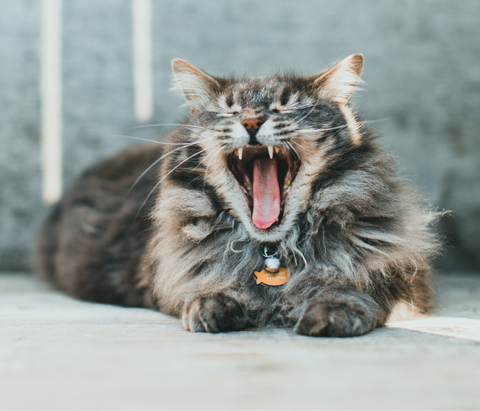
A little yawn…a little meow in your face…and whoa!! What the heck?
Let’s face it: kitty breath is rarely a bouquet of roses. There’s a perfectly good reason for that.
But if your cat’s breath is suddenly worse than normal, it’s something to take notice of.
Let’s jump into all the possible reasons why your cat’s breath might smell bad, and when it’s time to call the vet.
What does “normal” cat breath smell like?
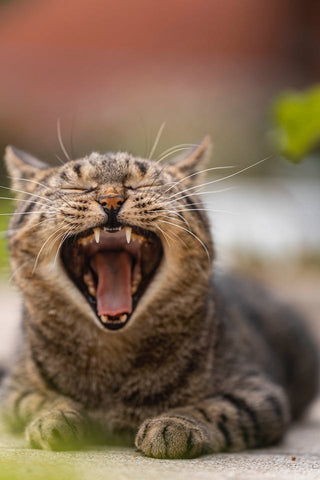
A somewhat-unlovely breath odor is normal for any animal who eats meat, and cats, who are obligate carnivores, should really be eating meat exclusively.
Certain bacteria love the protein in meat,[1] and, as those bacteria begin to break the proteins down, ammonia is released. It’s the ammonia that gives meat-eaters’ breath a funky edge.
Fish is the kind of protein that ammonia-producing bacteria love, and it also contains compounds called trimethylamines. Trimethylamines are what give fish its fishy smell.[2] Cats who eat fish-flavored cat food have an extra reason to have stinky-ish breath.
Note that cats who eat wet food might have even stronger-smelling breath than cats who mostly eat dry food. But don’t let that be a reason to stop feeding healthful wet food.
(Read about the advantages and disadvantages of wet food versus dry in this post.)
But if your cat’s breath is worse than normal…
But normal cat breath isn’t all that terrible. You might not wear the scent as cologne, but it’s not horrifying.
The point at which you should start to worry is when the smell of the breath becomes disgusting.
According to Dr. Eric Davis, a fellow of the Academy of Veterinary Dentistry and former director of the Dental Referral Service at Cornell University’s College of Veterinary Medicine, a healthy cat’s breath might smell, but it should not be offensive.[3]
If it’s really yucky, your cat might have a problem.
The most common reason for bad breath in cats

If your cat has bad breath that goes beyond the normal odor of a kitty mouth, chances are your cat is suffering from periodontal disease. Studies suggest that 50-90% of cats over the age of four are dealing with periodontal disease.[4]
What is periodontal disease?
Periodontal disease is what happens when the gums and bone that surround the teeth in a cat’s mouth become inflamed and infected.[5] The risk of periodontal disease starts the minute a cat puts food in her mouth.
Food > plaque > tartar > periodontal disease
Food, saliva, and bacteria mix in a cat’s mouth, forming a sticky, acidic film called dental plaque.[6] This happens to humans, too.
If you don’t brush your cat’s teeth shortly after the plaque starts clinging, it turns into another substance, called tartar. Plaque can turn into tartar within a few days.
Unlike plaque, which is soft and brushable, tartar is hard, and sticks firmly to teeth. This is because minerals in saliva become incorporated into the plaque. Tartar can really only be removed by a vet or veterinary dentist.
Once tarter starts to form, a vicious cycle begins. Tartar has a rough surface which makes it even easier for plaque to stick. The more tartar there is, the more tartar there’s going to be.
What’s so bad about tartar on a cat’s teeth?
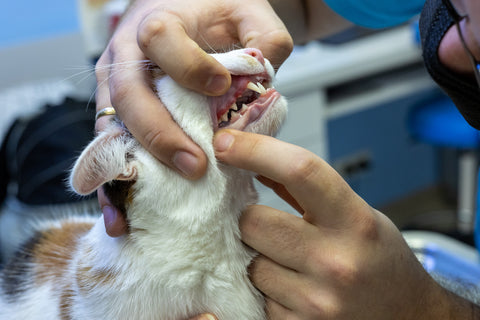
The problem with tartar is that it causes gum disease, which is another term for periodontal disease. How does a little crust on the teeth wreak so much havoc?
Plaque and tartar love to collect at the edge of the gums and just underneath. This bumpy substance creates little pockets of space that are the perfect home for harmful bacteria, which multiply like crazy under the gums.[7] This leads to a condition called gingivitis.
Gingivitis is an irritation or inflammation of a cat’s gums. It’s the mildest form of periodontal disease.
How do you know that your cat has gingivitis? Look for:
- Bad breath
- Bleeding gums
- Red mouth or gums
- Inability to eat, or lack of appetite
If your cat has gingivitis and gets proper veterinary dental care, you can still turn the ship around. Gingivitis is treatable, and your cat will not have to suffer the effects of more severe periodontal disease.
What happens if gingivitis is not treated?
If gingivitis is not treated, however, it can progress to periodontitis, which is very serious, and not reversible. It can lead to pain and tooth loss, or worse.[8]
Infection caused by the overgrowth of bacteria can cause gums to pull back, exposing more of a tooth’s root. It can also cause the ligament that normally holds teeth in place to weaken. Infected teeth, with nothing holding them in the jaw, can loosen and fall out.
The bacteria around the roots of infected teeth now has access to the blood stream. Studies in dogs have shown that pups with severe periodontal disease have damage in their kidneys, hearts, and liver, all caused by these rogue bacteria.[9] It’s likely true of cats, too.
Stomatitis, another mouth disease in cats
No conversation about bad breath in cats would be complete without a mention of stomatitis.
Stomatitis is a terrible and devastating mouth disease in cats. It’s a serious inflammation of the roof of the mouth, back of the mouse, tongue, and lips that causes extreme pain. Cats with stomatitis have swollen, bleeding gums. It hurts just to open the mouth.[10]
We don’t know exactly what causes stomatitis, but the current theory is that the cat’s immune system overreacts to bacteria in the mouth. There is some thought that it might be a hypersensitivity or an allergic reaction to plaque.[11]
It also seems to be associated with certain diseases, including feline leukemia virus, feline immunodeficiency virus, calcivirus, or Bartonellosis, which cats get from fleas.[12]
Often, the recommended treatment for stomatitis is removing all of a cat’s teeth, which sounds very dramatic. But that’s how bad this disease really is.
Full-mouth extraction is typically the go-to treatment option that vets will often recommend first. Trying to solve the problem using less-invasive options first – such as steroids and antibiotics – often makes it less likely that extracting the teeth later on will resolve this disease.[13]
Stomatitis is not a disease you would wish upon your cat’s worst enemy.
Other things that cause bad breath in cats
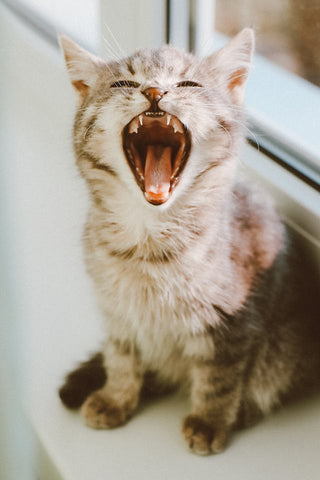
While periodontal disease is the most likely cause of very bad breath in cats, it’s not the only cause. Bad breath can be a canary-in-a-coal-mine indicator that something else is going on in your cat’s body.
Bad breath in cats who do not have periodontal disease could be caused by:
Kidney disease. In a cat with failing kidneys, urea, which is supposed to end up in urine, ends up in a cat’s breath instead. A cat with kidney disease will have breath that smells a bit like cat pee.[14]
Read all about chronic kidney disease (CKD) in this post.
Intestinal blockage. Food that is unable to be digested due to a blockage in the digestive tract (from swallowing a string, for example) will cause a foul odor to make its way back to the mouth.
Liver disease. If the liver is unable to filter toxins the way it’s supposed to, dimethyl sulfide, which smells like sulfur, will find its way to the lungs. The smell of a cat’s breath in end-stage liver disease is called “fetor hepaticus” or “breath of the dead.”[15]
Diabetes. A cat with diabetes may have a sweet or fruity smell to the breath. As the liver breaks down fat, acetone is created. In cats with diabetes, acetone is metabolized instead of sugar, and this is what causes the fruity odor.
Other mouth issues. Infection from an oral trauma, such as from biting an electrical cord, could cause an unpleasant breath odor. Ulcers, sores, or even cancer of the mouth or lips could cause an unpleasant smell.
Something caught in a cat’s teeth or under her gums, including something as simple as a particle of food, could cause an odor as it starts to decompose. Cats who have just vomited, and kittens who are teething, can also suffer from bad breath.
When should you call the vet if your cat has bad breath?
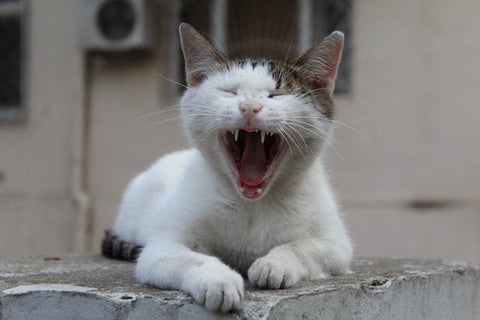
If your cat has stinky breath that goes beyond his normal odor, call your veterinarian as soon as possible. Cats have an instinct to hide their pain because pretending to be healthy can save them from predators in the wild. So, it can be tempting to put off a visit to the vet because it’s “only” bad breath, and because your cat doesn’t look very sick.
But we all know how painful some of the conditions – like rotting teeth – that cause bad breath can really be.
Your cat might need a professional tooth cleaning to save her teeth, an antibiotic for a mouth infection, or treatment for one of the more serious diseases, like kidney disease, liver disease, or cancer. None of these things get better on their own, and waiting only makes your cat suffer longer.
What happens during a professional teeth cleaning for a cat?
In order for your vet to really get a good look inside your cat’s mouth, and to get X-rays, your cat will need to be placed under general anesthesia. This is for your cat’s benefit, too, as a dental cleaning would be too stressful for him otherwise.
Your vet will likely perform bloodwork to make sure that her kidneys and liver can handle anesthesia prior to the procedure.
While under anesthesia, your cat will have his teeth scaled, meaning the plaque and tartar above and below the gumline will be scraped off. The teeth will also be polished to remove microscopic scratches that would otherwise attract more plaque.
If there are any teeth that are too severely affected by periodontal disease, they will have to be extracted.
Can I descale my cat’s teeth at home?
Even if you have the most cooperative cat in the universe, and have access to a tooth scaler, it is not recommended that you attempt to remove the tartar on your cat’s teeth yourself.
There are two main reasons why:
- Without general anesthesia, it is impossible to painlessly remove the tartar that lives below the gumline, and this is the tartar that causes the most damage.
- Scaling teeth causes microscopic scratches on the enamel which must be professionally polished away (under anesthesia) after. Otherwise, tooth scaling could, ironically, just lead to more periodontal disease.[16]
Brushing is the only way to prevent periodontal disease in cats
The most important thing you can do to prevent periodontal disease is to regularly brush your cat’s teeth.
In a perfect world, you would brush your cat’s teeth twice a day, every day. But, none of us live in a perfect world, so do the best you can to brush your cat’s teeth as often as you can.
So, there are two ways you can go regarding brushing your cat’s teeth. You can aim to use a real toothbrush and a real tooth gel, designed for cats. Or, you can “brush” your cat’s teeth with either a Q-tip or a plain piece of medical gauze.
Both methods will physically wipe away the plaque, and that is the most important thing. If you think your cat will better tolerate a Q-tip or gauze versus a toothbrush, or if you think you would be more likely to use one method over the other, go with what you think will get your cat’s teeth brushed more often.
The main advantage of tooth gels is that they are designed to adhere to the teeth to reduce the buildup of plaque and tartar in between brushings.
Choose products approved by the Veterinary Oral Health Council
(*Note: as an Amazon Associate, I may earn from qualifying purchases.)
If you want to try tooth gel, it should be one formulated for cats and approved by the Veterinary Oral Health Council (VOHC). The VOHC evaluates the scientific data available on each product for confirmation that they really work to prevent periodontal disease.
You can always check this list of VOHC-approved products for an up-to-date listing. Here are some of the products that made the cut. Note that the HealthyMouth products can only be ordered directly from the company’s website.
- Healthymouth Topical Gel for Cats
- Healthymouth Anti-Plaque Wipes for Cats
- ProDen PlaqueOff Powder
- CEVA Clenz-A-Dent ProDen PlaqueOff Powder
Any gauze pads will do, but I’d choose a smaller pad that’s made by a reputable company, since they’re going in your cat’s mouth. These 2” x 2” pads by McKesson would work. The Q-tips don’t have to be anything fancy either. I actually buy the Q-tips brand myself.
If you decide to try using a toothbrush, I like this little tiny one by MIND UP.
How to brush your cat’s teeth
The problem with brushing your cat’s teeth is that she probably won’t let you (at first).
Before you can even start brushing, you’re going to have to get him used to the idea first. It can take a while: weeks or even months before your cat will accept you messing around with his mouth.
Whatever you do, don’t just grab a toothbrush and jam it in. No teeth will ever get brushed if you take this approach.
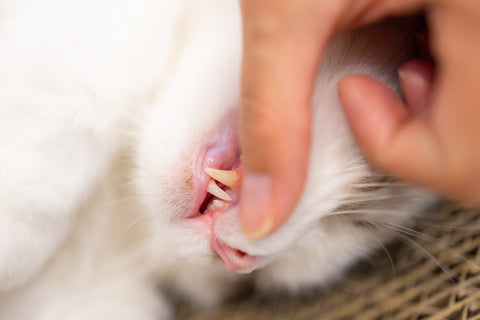
Whatever you do, make it pleasant, and don’t stress your cat. It’s not worth a bite or scratch, and it won’t help you get those teeth brushed over the long term.
What not to do when brushing your cat’s teeth
Don’t use human toothpaste, which can upset a cat’s stomach.
And don’t worry about the tongue-side of your cat’s teeth. I don’t think I’ve met a cat who would tolerate that kind of interference with his mouth.
Just disrupting the development of plaque along that line between tooth and gum on the outside of the teeth will go a long way toward preventing periodontal disease.
And fresher breath.
Love Pinterest? Here's a Pinterest-friendly pin for your boards!
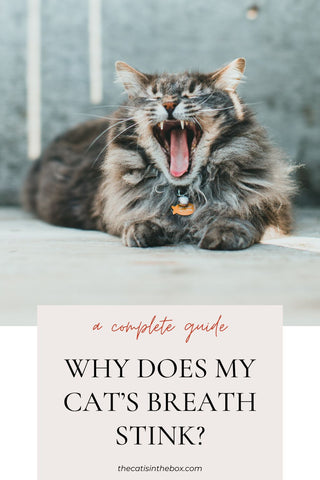
Dawn LaFontaine
Dawn LaFontaine is a lifelong animal lover who always seems to have a little pet hair in her keyboard. Her blog, Kitty Contemplations, helps cat guardians better understand and care for the special beings they share their lives and homes with. Her cat-products business, Cat in the Box, sells beautiful, well-made, and award-winning products that she designed to meet the biological needs of cats.
_______________
FOOTNOTES
[1] Why Vegetarians Don’t Have to Worry about Bad Breath - Colgate, www.colgate.com/en-ph/oral-health/bad-breath/do-vegetarians-have-fresher-breath. Accessed 31 Oct. 2023.
[2] “8 Foods That Cause Bad Breath | Livestrong.” LIVESTRONG.COM, Leaf Group, www.livestrong.com/article/13731506-foods-that-cause-bad-breath/. Accessed 31 Oct. 2023.
[3] “Bad Breath: Sign of Illness?” Cornell University College of Veterinary Medicine, 5 Aug. 2022, www.vet.cornell.edu/departments-centers-and-institutes/cornell-feline-health-center/health-information/feline-health-topics/bad-breath-sign-illness.
[4] “Feline Dental Disease.” Cornell University College of Veterinary Medicine, 21 June 2023, www.vet.cornell.edu/departments-centers-and-institutes/cornell-feline-health-center/health-information/feline-health-topics/feline-dental-disease.
[5] “Periodontal Disease.” Centers for Disease Control and Prevention, Centers for Disease Control and Prevention, 10 July 2013, www.cdc.gov/oralhealth/conditions/periodontal-disease.html.
[6]Cleveland Clinic. “The Sticky Truth about Dental Plaque.” Cleveland Clinic, my.clevelandclinic.org/health/diseases/10953-plaque. Accessed 31 Oct. 2023.
[7] “Bad Breath in Cats: Causes, Treatment & Advice.” Purina, www.purina.co.uk/articles/cats/health/dental/bad-breath-in-cats. Accessed 30 Oct. 2023.
[8] “Cat Dental Care: Cat Health Advice.” Cats Protection, www.cats.org.uk/help-and-advice/health/dental-care. Accessed 30 Oct. 2023.
[9] “Consequences of Periodontal Disease.” Veterinary Periodontal Disease Consequences. Accessed 30 Oct. 2023.
[10] Hospital, Countryside Veterinary. “Ew! Phew! The Causes of Bad Cat Breath - Vet in Toney: Countryside Veterinary Hospital.” Vet In Toney | Countryside Veterinary Hospital, 6 Dec. 2022, mycountrysidevet.com/65-2/.
[11] “Gum Disease in Cats (Gingivitis/Periodontitis /Stomatitis).” Home Health UK, 18 Aug. 2022, homehealth-uk.com/animalhealth/gum-disease-in-cats-gingivitis-periodontitis-stomatitis/.
[12] “Bad Breath in Cats: How to Prevent and Treat It.” PetMD, www.petmd.com/cat/general-health/bad-breath-cats-how-prevent-and-treat-it. Accessed 30 Oct. 2023.
[13] “Feline Stomatitis - Dental Disease in Cats.” Oregon Veterinary Dental Specialists, 27 Sept. 2023, orvetdentalspecialists.com/feline-stomatitis/.
[14] Estaff. “Bad Breath May Signal Illness.” Tufts Catnip, 18 Feb. 2020, www.tuftscatnip.com/cathealthandmedicine/bad-breath-may-signal-illness/.
[15] ibid.
[16] “Dental Cleaning in Cats: VCA Animal Hospital: VCA Animal Hospitals.” Vca, vcahospitals.com/know-your-pet/dental-cleaning-in-cats. Accessed 2 Nov. 2023.

